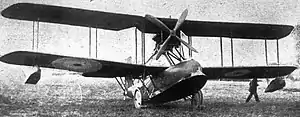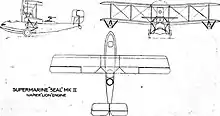Supermarine Seal
The Supermarine Seal was a British amphibian biplane flying boat developed by the Supermarine company. The Seal was further developed into the Supermarine Seagull.
| Seal | |
|---|---|
 | |
| Role | Reconnaissance flying boat |
| Manufacturer | Supermarine |
| Designer | R. J. Mitchell |
| First flight | May 1921 |
The Seal was designed to operate from either shore stations or warships, including the ability to land and take off from aircraft carriers.
Design and development

The Seal was a two-bay biplane with the lower wing mounted on top of the fuselage and the engine mounted below the centre-section of the upper wing. The primary structure of the fuselage was roughly circular in cross-section and was built of planking over a framework of formers and stringers covered with fabric, with the planing surfaces built as separate structures, divided into watertight compartments.[1]
Specifications (Seal II)
Data from Supermarine Aircraft since 1914[2]
General characteristics
- Crew: 3
- Length: 32 ft 10 in (10.01 m)
- Wingspan: 46 ft 0 in (14.02 m)
- Height: 14 ft 10 in (4.52 m)
- Wing area: 620 sq ft (58 m2)
- Empty weight: 4,100 lb (1,860 kg)
- Gross weight: 5,600 lb (2,540 kg)
- Powerplant: 1 × Napier Lion W-12 water-cooled piston engine, 450 hp (340 kW)
- Propellers: 4-bladed wooden fixed-pitch pusher propeller
Performance
- Maximum speed: 112 mph (180 km/h, 97 kn)
- Endurance: 4 hours
- Time to altitude: 10,000 ft (3,048 m) in 17 minutes
References
- "The Supermarine "Seal" Mark II: An interesting deck-landing amphibian fleet-spotter". Flight. 3 November 1921. p. 713.
- Andrews & Morgan 1987, p. 81.
Sources
| Wikimedia Commons has media related to Supermarine Seal. |
- Andrews, C.F.; Morgan, E.B. (1987). Supermarine Aircraft since 1914. London: Putnam. ISBN 978-0-85177-800-6.